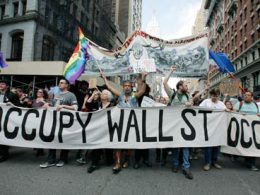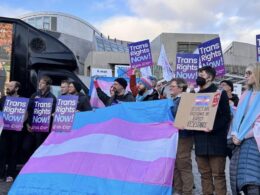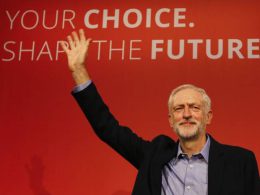By Peter Hadden
US AND British military chiefs have been quick to label their July offensive against the Taliban in south east Afghanistan a “success”. In reality the main achievement of the British “Operation Panther’s Claw” and the US “Operation Thrust of the Sword” has been to refocus the attention of an increasingly sceptical public at home on the military quagmire and political impasse that is present day Afghanistan.
TRUE, THE Taliban have, for now, been pushed out of some parts of their Helmand stronghold. In the main this has been because they have switched tack, retreating from direct confrontation with the superior firepower ranged against them, to concentrate on guerrilla attacks such as deadly roadside bombs. In the words of one commentator, the offensive might more accurately be described as “Operation thrust sword into the air”.
The cost of the offensive to the US, British and other occupying forces has been the highest monthly casualty figures since the 2001 invasion. 75 US and NATO troops were killed in July. August has continued in the same vein with six more US soldiers killed in the first two days.
The scale of the current fighting is clear evidence of just how little has been achieved in eight years of occupation and this despite the more than $170 billion spent by the US and the £12 billion spent by Britain on this unwinnable war – and despite the almost 750 US and nearly 200 British troops that have died.
For the people of Afghanistan the cost, inevitably, has been much higher. As in Iraq, none of the occupying forces bother to keep an accurate count of the Afghan combatants and civilians who have lost their lives. The Independent on Sunday recently estimated that 30,000 have been killed. The true figure is anyone’s guess. Meanwhile 3.7 million Afghans have fled into exile, mostly to Pakistan and Iran.
A failed strategy
The new offensive and the change in tactics now being attempted by the Obama administration is an admission that the strategy pursued up to now has failed. A Centre for Stategic and International Studies (CSIS) report published in July warns that Afghanistan could become “Obama’s Vietnam” and concludes that: “the situation has deteriorated into a crisis where the Taliban and other jihadist movements are now winning.”
To date the strategy of the occupying powers has been to try to smash the Taliban and enforce the rule of the puppet Karzai government by military means. This strategy has backfired completely. The US has relied overwhelmingly on air strikes, mortar fire and night raids to try to push the Taliban back and extend the authority of Kabul. They have also attempted an eradication programme to destroy the poppy production that accounts for 60% of the Afghan economy and provides much of the Taliban’s income.
During the campaigns of the last two summers US bombers were dropping 22 tons of ordnance on Helmand every month. With this Cambodian-style assault it is little wonder that an estimated two-thirds of those killed by the pro-government forces have died as a result of air strikes.
Unremitting poverty
Meanwhile daily life for the vast majority of the population is little or no better than under the Taliban. Eight years on from the invasion and 77% of people have no access to clean water. Five out of six people living in rural areas are not connected to the electricity grid. For those who are, including those in Kabul, power is only available at fluctuating voltages for a few hours per day. Female literacy – at 18% – has barely improved on what it was under the reactionary rule of the Taliban. With 42% of the population forced to survive on less that $1 dollar per day, life for most Aghans is one of unremitting poverty.
When they first came to power, the Taliban were made up in the main of fighters trained by the Pakistan military with recruits drawn from the exile population. Having grown up in the refugee camps in the North West Frontier Province (NWFP) and other parts of Pakistan, they had few social roots and very little base in Afghan society.
The methods used by the occupying powers – together with the total failure of the corrupt Karzai government to improve the life of the people – have only served to broaden the base of the insurgency, with local tribes and disaffected young Afghans prepared to join the fight.
By the time Obama took office – and with Afghan presidential elections due to be held on 20 August – the Taliban were at the gates of Kabul with much of the Pashtun areas to the east and south under their effective control. The writ of the government did not run much further than the capital. Most of the territory nominally under its control was actually run by Tajik, Uzbek, Hazara and other warlords, who pay lip service to Kabul while continuing to rule and enrich themselves in their own areas.
Opium stockpiles
As for the opium eradication, the reality is that Afghanistan – Helmand in particular – has since 2005 been producing twice the world’s supply, much of it now stockpiled by the Taliban to keep up the price and ensure that the $3 billion or so annual income from this crop is maintained.
Obama has responded with a change in top military personnel and a change in tactics.
There is to be less reliance on air power and more on troops on the ground. The military objective is to take areas and then try to hold them and build support among the local population. Troop levels are to be increased to 100,000. But more troops on the ground and less air strikes to obliterate opposition inevitably mean more casualities. As more soldiers come home in body bags, and as opposition to this futile conflict mounts, the danger is that the war will not be lost in Helmand but on the streets of US and British cities.
The US and British governments have been forced to recognise that there can be no purely military victory. Their aim is to deal a stunning blow to the Taliban while working out some political arrangement that would “put an Afghan face on the way forward”. Thus they hope that – somewhere way down the line – an exit strategy will eventually take shape.
This may look well in the Pentagon’s war games rooms, but implementing it in Afghanistan is a different matter. The only “Afghan face” available at the moment is the Karzai government, and the chances that it ever could be made credible to the majority of Afghans are slender indeed. Although he was on only 15% in an early private opinion poll it is likely that Karzai will win the presidential election – but only because of the complete lack of any alternative candidate.
Hopes that a new Karzai government may be less corrupt and less inept than the present one have been dealt a blow by his decision to appoint notorious warlord, Mohammad Fahim, as his running mate.
The CSIS report advocates that, for the Kabul government to maintain control, it would need a 240,000-strong army plus 160,000 police. To date the efforts of the Coalition to build the strength of the police and army to 134,000 over three years have failed. The Kabul government is a fiction, with real power in the hands of the warlords, and the country, in reality, divided along national and tribal lines. The idea that this government can somehow acquire the authority to command a force of 400,000 seems little more than wishful thinking.
As Max Hastings, writing in the Financial Times, puts it: “If the west loses it will be for the same reason the US lost in Vietnam: ‘our’ Afghans may prove no more viable than were ‘our’ Vietnamese”.
“Surge”
George Bush’s “surge” in Iraq was, as much as anything else, a surge of money handed over to former enemies. In the Anbar area the US paid 100,000 Sunni insurgents $300 per head per month to recruit them as a peacekeeping force. Now there are reports that the Obama administration, in its attempt to split the Taliban, is considering a payment of $150 per month to up to 250,000 current fighters if they switch sides.
The Anbar initiative worked for a period in Iraq, but at the cost of possible future clashes between Sunni forces and the Shia-dominated government forces. In Afghanistan things are much less likely to go according to plan. The Pakistan government has set a precedent with a series of deals with Taliban and other Islamic militants. All have come to grief – the collapse of the deal struck with the Taliban in the Swat valley area in February is only the most recent example.
Pakistan
Which brings us to perhaps the biggest obstacle standing in the way of the US administration – the situation in Pakistan. Imperialist intervention in this region over several decades – going back to the support given via the Pakistan military to the mujahideen groups who fought the Russians – has regionalised this conflict.
The border between Afghanistan and Pakistan is a line drawn by an Englishman, Sir Mortimer Durand, in 1893 to mark the limits of Britain’s military advance, not the recognition of any differences between the people of the area. Now the Pashtun areas on both sides of this line are in revolt. The Pakistan military, under US pressure, are conducting a brutal offensive against Pakistani Taliban and other Islamic groups, that, up until very recently, they had been arming and training.
The recent offensive in the Swat valley involved 40,000 troops and resulted in the displacement of two million people. These methods, if they are pursued in other Taliban strongholds in the tribal areas, threaten to create a second Afghanistan within Pakistan. Obama, while concentrating on his limited “surge” in Helmand, can find himself faced with a much wider insurgency that could pose the break up, not just of Afghanistan, but also of Pakistan.
This deepening quagmire is the legacy of decades of imperialist intervention in the region. It is the people of Afghanistan and Pakistan who are now paying the price. At present they have only the choice of military oppression by government or foreign troops, or domination by warlords or reactionary religious zealots.
An alternative is needed. All foreign troops should be immediately withdrawn from the region. It is the people of the area who must find a way out. The working class, especially the working class of Pakistan, have the key role in fighting for a socialist alternative that would unite all the oppressed across tribal, national and religious barriers.












